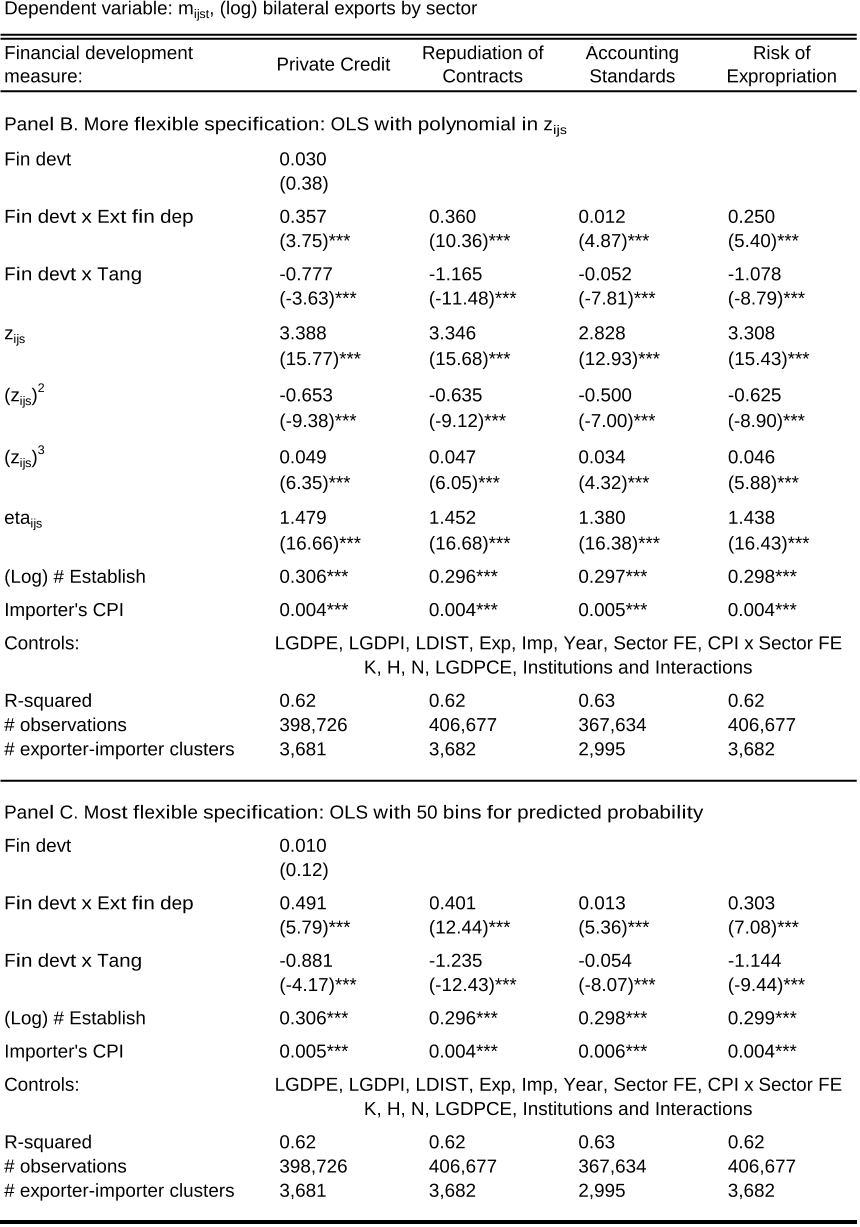Credit Constraints, Heterogeneous Firms and International Trade
Reads0
Chats0
TLDR
This article examined the detrimental consequences of financial market imperfections for international trade and developed a heterogeneous-firm model with countries at different levels of financial development and sectors of varying financial vulnerability.Abstract:
This paper examines the detrimental consequences of financial market imperfections for international trade. I develop a heterogeneous-firm model with countries at different levels of financial development and sectors of varying financial vulnerability. Applying this model to aggregate trade data, I study the mechanisms through which credit constraints operate. First, financial development increases countries' exports above and beyond its impact on overall production. Firm selection into exporting accounts for a third of the trade-specific effect, while two thirds are due to reductions in firm-level exports. Second, financially advanced economies export a wider range of products and their exports experience less product turnover. Finally, while all countries service large destinations, exporters with superior financial institutions have more trading partners and also enter smaller markets. All of these effects are magnified in financially vulnerable sectors. These results have important policy implications for less developed economies that rely on exports for economic growth but suffer from poor financial contractibility.read more
Figures

Table 10. Economic Significance: Predicted vs. Actual Trade Growth 
Table 9. Economic Significance: Comparative Statics 
Table 5. Financial Development and Firm-Level Exports 
Figure 3. The Productivity Cut-off for Exporting 
Table 5. Financial Development and Firm-Level Exports 
Table 1. Export Patterns in the Data
Citations
More filters
Posted Content
The Macroeconomics of Financial Integration: A European Perspective ∗
TL;DR: In this article, the macroeconomics of international financial integration from a European perspective are discussed. But the authors focus on the role of financial integration in promoting economic convergence among members of the European Union and assess how increased financial integration has altered the economics of external adjustment.
Journal ArticleDOI
Causality between credit depth and economic growth: evidence from 24 OECD countries
TL;DR: In this article, the authors investigate causality between the ratio of domestic private credit to GDP and growth in real GDP per capita in a country-by-country time-series framework for 24 OECD economies over the period 1980-2013.
Journal ArticleDOI
Trade shocks and credit reallocation
TL;DR: In this paper, the authors explore a novel channel, namely the reallocation of credit in the aftermath of a trade shock and find that there are endogenous financial frictions that arise from trade liberalization and spillovers between losers and winners from trade that go through banks.
Posted Content
Credit constraints, foreign ownership, and foreign takeovers in Germany
TL;DR: In this paper, the authors investigated the impact of foreign ownership and credit constraints on the target firms' credit constraints for the first time and found that foreign owned firms in German manufacturing on average show slightly more financing restrictions than domestically owned enterprises, but this small difference diminishes once unobserved heterogeneity is taken into account.
Posted Content
Financial constraints and foreign direct investment: firm-level evidence
TL;DR: In this paper, the authors developed a model of multinational firms facing real and financial barriers to foreign direct investment (FDI), and analyzed their impact on the FDI decision, finding that financial factors constrain firms' foreign investment decisions, an effect felt in particular by firms most likely to consider investing abroad.
References
More filters
Posted Content
Law and Finance
Rafael La Porta,Rafael La Porta,Florencio Lopez de Silanes,Florencio Lopez de Silanes,Andrei Shleifer,Andrei Shleifer,Robert W. Vishny,Robert W. Vishny +7 more
TL;DR: This paper examined legal rules covering protection of corporate shareholders and creditors, the origin of these rules, and the quality of their enforcement in 49 countries and found that common law countries generally have the best, and French civil law countries the worst, legal protections of investors.
Journal ArticleDOI
Law and Finance
TL;DR: In this article, the authors examined legal rules covering protection of corporate shareholders and creditors, the origin of these rules, and the quality of their enforcement in 49 countries and found that common-law countries generally have the strongest, and French civil law countries the weakest, legal protections of investors, with German- and Scandinavian-civil law countries located in the middle.
Journal ArticleDOI
The Impact of Trade on Intra-Industry Reallocations and Aggregate Industry Productivity
TL;DR: This paper developed a dynamic industry model with heterogeneous firms to analyze the intra-industry effects of international trade and showed how the exposure to trade will induce only the more productive firms to enter the export market (while some less productive firms continue to produce only for the domestic market).
Journal ArticleDOI
Finance and Growth: Schumpeter Might Be Right
TL;DR: In this paper, the authors examined a cross-section of about 80 countries for the period 1960-89 and found that various measures of financial development are strongly associated with both current and later rates of economic growth.
ReportDOI
Financial Dependence and Growth
Raghuram G. Rajan,Raghuram G. Rajan,Raghuram G. Rajan,Luigi Zingales,Luigi Zingales,Luigi Zingales +5 more
TL;DR: This paper examined whether financial development facilitates economic growth by scrutinizing one rationale for such a relationship; that financial development reduces the costs of external finance to firms, and found that industrial sectors that are relatively more in need of foreign finance develop disproportionately faster in countries with more developed financial markets.